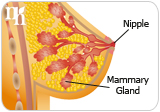
Estrogen and progesterone are considered synergistic partners when it comes to the female reproductive system. They work well together to maintain a woman's fertility and menstrual cycle. However, when the balance between these two is thrown off, estrogen dominance may occur, raising your risk of developing several serious disorders. Although the concept is easy to understand, the causes of estrogen dominance may not be so clear cut.
While it's true that a woman with extremely high levels of estrogen can suffer from estrogen dominance, a woman with low levels may face the same condition, if she also possesses little to no progesterone. Read on to find out what diseases and disorders are caused by too much estrogen, as well as how an excess of estrogen occurs in the body.
Disorders and Diseases Caused by Estrogen Dominance
One of the primary responsibilities of estrogen is to direct the multiplication of cells in certain areas of the body that are involved in reproduction; for example, the breast, the midsection, and the uterus. However, this hormone may also stimulate the multiplication of harmful tissues in these areas and - in some cases - speed up the process of spreading cancerous cells. This process can have serious consequences; among the most common conditions associated with estrogen dominance include:

- Breast cancer, uterine cancer, and ovarian cancer
- Weight gain
- Endometriosis
- Lupus
- Osteoporosis
- Thyroid disorders
Keep reading to discover how you may be producing or ingesting too much estrogen, and what you can do to balance your hormone levels and avoid these serious conditions.
5 Ways Estrogen Dominance Occurs
Phytoestrogens
These are plant compounds found in herbs like black cohosh and dong quai, as well as food products such as soy and flax seeds. The chemical makeup of phytoestrogen prompts the body to accept them in the same way as it would accept its own estrogen. Consuming phytoestrogens as an alternative treatment to hormone replacement therapy (HRT) has been a source of controversy, because phytoestrogens can sometimes cause the body to stop producing its own estrogen efficiently.
Cattle and poultry
Commercially reared chicken and beef; for example, are sometimes given growth hormones that resemble estrogen. When we consume meat, the chemicals are absorbed into the bloodstream, making them potentially dangerous to our hormonal balance.
Xenoestrogens
These are chemical compounds that our body recognizes as estrogen, even though they are not produced in the body. They are found in many personal care products, such as skin creams and shampoos, as well as pesticides, glues, auto exhaust, and nail polish.
Naturally occurring estrogen
In some cases, your body produces too much estrogen on its own. Obesity is an example of a condition that stimulates abnormally high estrogen levels because the body converts fat into estrogen.
HRT
This type of procedure replaces dwindling hormone supplies with hormones created in a laboratory during menopause. Estrogen-only HRT is available; however, this comes with serious side effects such as increased risk of cancer and blood clots.
Altering the amount of estrogen in your body, whether naturally or artificially, should be discussed with a doctor and researched thoroughly in advance.
More Information about Estrogen Dominance
Estrogen is one of several factors that can cause hormone dominance; androgens (testosterone) and prolactin can also cause hormonal imbalance. Click on the following link to learn more about high hormone levels.
